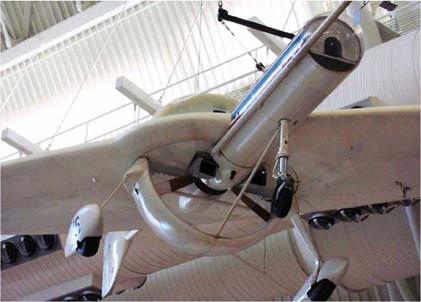Propulsors
Propulsors have been around for many years now, their origin dating back to 1910. The propulsor is a propeller of short radius mounted inside a duct or shroud, hence its alternate name of Ducted Fan or Shrouded Prop. It is ideally suite to special purpose-built light aircraft or airships, which are designed to fly missions at around 80 knots or slower.
Due to resonance effects, Propulsors always have an odd number of blades, usually around five-blades per prop. The prop blade radius is relatively small around 0.72 times the size of a conventional propeller, but the propulsive efficiency is as good as or better than a normal propeller of greater diameter. The advantage of the smaller diameter of the Propulsor’s blades allows it to operate to higher RPM without propeller reduction gear, before the tip speed suffers from compressibility problems. It will produce a similar amount of static prop thrust per horsepower as a prop 1.3 times larger due to the presence of the shroud. The shroud’s air intake section is bell shaped, or to be precise, it is an annular airfoil. The shroud is designed specifically to help smooth the airflow through the prop disc. The air’s inflow velocity into the shroud increases, resulting in a drop in air pressure in front of the prop. The air flow then exits the duct with the air flow stream tube the same diameter as the duct exit, as opposed to the vena contracta of a conventional prop. Prop tip vortices will be greatly reduced due to the close tolerance between the prop tips and the shroud. Because the propeller radius is shorter than a conventional propeller, it follows the blade tip speed will be lower resulting in less prop noise and freedom from compressibility problems In the rare event of the prop
|
An Unmanned Aerial Vehicle (Drone) powered by a Ducted Fan. This UAV resides in the Udvar-Hazy Centre, Chantilly, Va. |
throwing a blade, it could be contained within the shroud, a distinct advantage especially on an airship!
Although the Propulsor has some advantages over the conventional prop, it does have some disadvantages too. The shroud will absorb some of the noise making it quieter to observers at the side of the aircraft (it is ideal for airships). However, this advantage is offset by the fact the noise will be focused fore and aft, making it noisier in those areas, which is where the cabin is located on single-engine Propulsor aircraft. The shorter radius of the prop could imply a saving in weight, but this may be offset by the weight of the extra blades (usually five or more). In addition, the weight of the shroud must also be taken into account, plus its extra cost and drag penalty. For all the Propulsor’s advantages and disadvantages, only a small increase in efficiency is realized, and that is mostly at the low end of the speed range.
Some helicopters have a Ducted Fan tail rotor known as a Fenestron, a type of Propulsor. The French Aerospatiale’s Gazelle (1967) and Dauphin (1972) helicopters both have a thirteen blade, composite Fenestron mounted in a duct within the tail boom for improved performance, replacing the conventional tail rotor. The later 1989 model Dauphin’s fenestron has only eleven blades to further improve its performance
To conclude, the propulsor powered aircraft has its propulsive efficiency suited to the lower end of the speed range. At the high end of the speed range, the propulsive efficiency of the Propfan is suited to the medium range airliner, designed to cruise at speeds closer to those of the jet-powered aircraft with turboprop efficiency.












